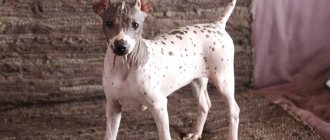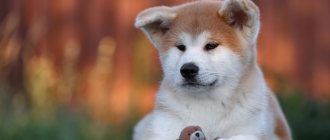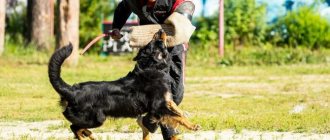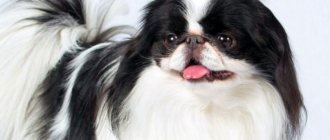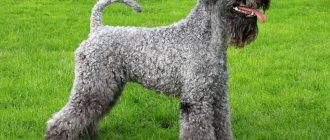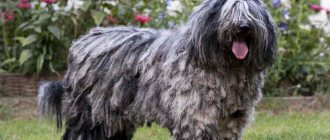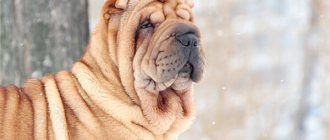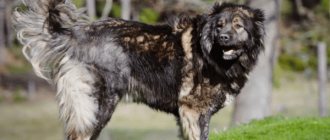Preparing your home for a puppy
Little pit bulls are ready to go to a new home after they are 1.5-2 months old.
But good puppies are booked long before this date. And future owners have time to prepare for the pet's arrival. To ensure the safety of the new family member and the safety of property, you need to remove wires, fragile things and small objects in advance. Since the puppy will go to the toilet at home at first, it is advisable to remove the carpets from the floor.
https://www.youtube.com/watch?v=subscribe_widget
To provide the pet with proper care, future owners will have to visit a pet store and purchase:
- Bowls for food and water. It is desirable that they be metal and attached to a tripod, which is adjustable in height.
- Collar and leash. It is better to buy them cheaper, because a pit bull puppy grows quickly and at first the equipment will have to be changed frequently.
- Toys. They must be made of durable material and not have elements that can be chewed off or swallowed.
- Hygiene products. To care for a pit bull, you will need a nail clipper, shampoo, a comb-mitten, lotions for wiping the eyes and cleaning the ears.
- Diapers. In order not to turn your house into a toilet for your pet, it is better to teach him to use disposable diapers.
- A bed or mattress with a removable cover that can be washed.
Popular pit bull colors
The pit bull breed is represented by 8 loci, and the pigmentation of the coat can be very diverse: white spots, black opals, tiger stripes.
Pit bull pigmentation is conventionally divided into the following types:
- Solid: brown, red, red, fawn, black, brown and white;
- Brindle: brindle and white, black and brindle, chocolate brindle with white markings, light chocolate colors;
- Spotted: white with red, grey, black and chocolate markings.
The most common color of pit bulls is red. The main colors of the breed are also considered black, blue and chocolate. Pit bull puppies are typically born with tan marks and a dark mark (stripe) on their back. As it grows, the tan gradually disappears.
There are also different types of tan marks. In some individuals it is so blackened that it is almost impossible to see. Due to the extensive opal, the dog may resemble a saddleback. The color of the tan of pit bulls can be varied: from brick (Dobermans are born with a similar color) to white. Moreover, its brightness depends on another locus.
There are pit bulls with brindle marks on their tan markings to match their main color. Such dogs are called brindle. Today you can find pit bulls of any color except merle. This color is prohibited in the breed, since the presence of merle alleles can provoke the development of numerous diseases in the individual.
Description of the breed
Until now, the breed is reaping the benefits of its notoriety - in some European countries there is a ban on breeding these animals. In other countries they are treated with caution: their developed muscles, menacing gaze and terrifying grin have created a stereotype about killer dogs.
Only pit bull puppies can cause tenderness, but not for everyone - as soon as a person learns the name of the breed, distrust of the animal automatically creeps in.
People don’t even think that under the aggressive mask created by myths hides a wise, calm and devoted creature. Any dog can be turned into an inadequate monster - it depends only on the owner. If he raises the pit bull correctly, he will receive in return a loyal friend who will never show aggression towards people.
Breed characteristics:
- height – 45-50 cm;
- weight – on average 14-28 kg;
- muzzle – rectangular, medium size, widening towards the forehead;
- ears – cropped according to the standard or remain intact;
- physique – strong, fit, with pronounced muscles;
- tail – shortened, located low, tapering towards the tip;
- coat – short, guard;
- color - any, only merle (marble) is prohibited.
Pit bull standards fall into wide ranges as the breed is not internationally recognized by dog handlers. You can get a pedigree for your pet, but you cannot participate in exhibitions with it.
A newborn pit bull puppy is born with its eyes closed and cannot hear. In addition, puppies cannot warm themselves or defecate - their mother helps them with this.
But puppies have a well-developed sucking reflex, and along with it their sense of smell - so they can independently find their mother’s nipple.
The weight of a healthy newborn pit bull puppy ranges from 250–500 grams, and the body length from nose to tip of tail is 15–20 centimeters.
Origin story
The breed dates back about 300 years, and was bred precisely as an ideal fighting unit. Presumably, the ancestors of pit bulls were brought to America from England and Ireland. Already there the breed was improved and used in dog fighting due to its amazing combination of strength, endurance and reaction speed. Because of this, terrible myths about terrible killing machines appeared.
For some time, it was even forbidden to breed pit bulls, and their numbers were strictly controlled. But now the situation has returned to normal, and the breed is again very popular in the USA and Russia. By the way, pit bulls are successfully used by the police to search for explosives and drugs. The menacing dogs have become excellent companions and rehabilitation workers.
Breed Features
Caring for a small pit bull is more troublesome than caring for an adult dog. A puppy requires more time and attention. He needs to be toilet trained and follow a strict routine, as well as fed and taken out for walks more often.
Until the puppy has received all its vaccinations, it should not be placed on the ground - it can catch an infection from an animal running there.
Until 4 months, a small pet should not be allowed to jump from heights or go down stairs on its own. A weak puppy can get injured or have bad posture.
In order to raise a stately pit bull terrier from a clumsy baby, he needs to create the correct feeding regimen:
- A 3-4 month old puppy is given food 5 times a day.
- At 4 months he is transferred to 4 feedings a day.
- At 6 months the pet is fed 3 times a day.
- A one-year-old Pit is given food twice a day.
As you know, pit bulls are fighting dogs. This is something to consider before getting them. It is very important to give them the opportunity to socialize. To do this, the puppy must spend a lot of time among other animals. Ideal if you have a cat or other dogs at home. Otherwise, a grown-up pit bull will perceive any animal as prey and a threat - after all, they were bred to fight with dogs and even bulls.
These dogs are amazingly fond of praise. And they are ready to do anything for her - like tearing the neighboring dog into pieces, or bringing slippers to their beloved owner. Combined with his remarkable intelligence, this gives the owner an excellent opportunity to mold the puppy into exactly what he needs. Therefore, owners who justify the cruelty of their dogs by the characteristics of the breed usually either did their training incorrectly, or skipped this process altogether, hoping that everything would somehow work out without their participation.
Why is it important to properly raise pit bulls from puppyhood?
Selectors try not to use aggressive puppies for further breeding. Despite this, it is important to raise a dog with dignity so that in the future psychological qualities that are dangerous to humans do not creep into its character.
Important! Do not encourage the desire to bite and other aggressive actions of the puppy, create comfortable conditions for the pet for further development and everyday life. This is the only way to raise a calm, friendly and devoted friend.
How to choose an obedient puppy?
In order for upbringing to improve immediately and training to be successful, it is important for the owner to choose the right puppy. After all, it is almost impossible to rehabilitate a naturally aggressive child, a cowardly puppy will be afraid of active games, and an underdeveloped puppy will not be able to handle training and physical activity. When choosing a puppy, you need to look at all sides. It happens that the owner and the puppy immediately show mutual interest in each other. In this case, you don’t have to think for long.
Pit bull puppies
Table 1. Characteristics to look for when choosing a Pit Bull Terrier
| Parameter | Appearance | Color | Character | Floor | |
| Boy | Girl | ||||
| What should you pay attention to? | A well-developed baby should have a small head, straight, strong paws, and a slightly noticeable hump at the withers. | The most valuable pit bull terriers are those of the same color: gray, brown, black, white | The baby should not behave fearfully or viciously - hide from guests behind “mother” or attack a person and start biting |
|
|
Before you start searching for a seller, you need to decide on the purpose for which you are buying a pit bull. If as a pet, just choose a puppy you like. But, if participation in exhibitions and performances is expected, and the pet should bring only gold medals, the choice must be approached with special care:
- Examine the dog's parents, get acquainted with the documents. Parents must be healthy and adequate individuals.
- Do not buy an animal on the market or from private breeders. You should contact kennels where dogs are kept in decent conditions and vaccinated. A seller found through a private advertisement can easily deceive the buyer.
- Monitor the price and analyze. If the cost is very low, then perhaps the buyer is offered a mestizo - a cross with a mongrel or other dog.
The price of a puppy also depends on its age: the older the animal, the cheaper it is sold. It happens that animals at the age of 6 months are given away for practically nothing. It is very difficult to retrain a dog at this age, and the owner will have to put a lot of effort into training it.
Important! You cannot choose a pit bull based on a photograph: you need to come to the kennel in person, or better yet, several times to make sure that you have made the right choice. The breeder socializes the puppies very early, so already at 2 months the difference in character becomes apparent. It becomes clear how the puppy will grow up - angry or affectionate, friendly or withdrawn.
Preparation for purchase
Before the puppy appears in the house, it is necessary to create a pleasant, comfortable environment for him. The baby needs to allocate his own corner where the bed will stand. It is better to place it in the far corner of the room away from radiators and drafts. You need to prepare the following items:
- two bowls - for water and food. First, simple ones are taken; when the dog grows up, metal bowls on a stand are purchased;
- dry food, if such a diet is expected;
- a diaper where the puppy will pee. An oilcloth or rubberized mat should be placed under it so as not to spoil the covering on the floor. At first, the baby will do his business in the apartment, so you need to teach him to perform the ritual in a certain place;
Diapers for puppies
- collar and strong leash. There is no need to prepare a muzzle, because the puppy’s muzzle will still grow. They buy it for an already grown-up pet and take the puppy out for a walk only in a muzzle, because many people are afraid of pit bulls due to established stereotypes about aggressiveness;
- rubber toys, bones, ropes. The puppy needs to constantly chew on something to scratch the gums under the teething teeth;
The puppy chews on various objects
- cage or carrier. As a rule, newbies are frightened by the prospect of locking a puppy in a crate, but this is, first of all, to protect property and the pet itself. The puppy may chew on the owner's things, find a bottle of toxic cleaning substance, drink it, or lick the socket.
The baby's access area should be cleared of wires, fragile or expensive items. Pit bulls quickly get used to the fact that they are only allowed to chew on toys, but at first they all try to test their teeth.
Pit Bull Terriers love to drop things and see what happens.
Stages of development by month
As already mentioned, a newborn pit bull cannot see or hear, but it does have a developed sense of smell. During the first month of life, around the 10th to 14th day, the puppy's eyes and ears open.
By the end of the fourth week, most babies are ready to try solid foods and can actively play with each other.
2 months is the age at which socialization begins, when puppies are weaned from their mother. During this period, they already have a stronger physique, weigh from 6 to 9 kilograms, and their body length reaches 30 centimeters. By the end of the second month, the babies can already find owners.
3 months is the period when a purebred pit bull begins to acquire the standard appearance of the breed. The puppy's teeth change, the musculoskeletal system strengthens, and weight increases. At three months, a pit bull can weigh up to 14 kilograms and have a body length of 30–36 centimeters.
At 4 months, the puppy recognizes and recognizes its new owner, and the mental component of the dog’s personality begins to form.
At the age of 5 months, the replacement of baby teeth with molars will be completed.
The pit bull is actively developing during this period; the puppy’s weight can reach 24 kilograms and its body length is 45 centimeters.
We suggest you read: How to accustom a puppy to a leash and stop him from pulling while walking
6 months - the puppy enters adolescence and begins to understand what kind of hierarchy is established in the house. It must be shown that the dog does not play a dominant role in the family and must obey the owner. The puppy's character will emerge and he will begin to be stubborn, so it is important to quickly “put him in his place.” At this age, a young pit bull weighs up to 28 kilograms and has a body up to 48 centimeters long.
At 7 months, an ill-mannered puppy tries even more persistently to take the highest place in the home hierarchy; during this same period, puberty occurs - girls begin to go into heat, male pit bulls can show aggression or begin to “sit” on pieces of furniture, toys, legs and hands of the owners.
At 8 months, the dog will develop and strengthen those character traits that it will retain throughout its life. At this age, the puppy already looks like an adult pit bull; it can weigh up to 35 kilograms with a body length of 48–50 centimeters.
The final period of a puppy’s maturation is the 9th–12th months. The American Pit Bull Terrier is already acquiring a characteristic exterior, has a formed body and established character traits. If the owner was unable to teach the growing pit bull manners by this age, then in the future the dog will be less amenable to training, and an inexperienced owner may not be able to cope without the help of specialists.
Choosing a puppy
The most important criterion when choosing a pita is a good pedigree. A purebred baby is less susceptible to aggression and mental disorders. Selection work gradually reduces the dog's excitability. A hand-bought pita or mixed breed can turn into the same killer that the media is constantly talking about. In addition, breeders guarantee the proper level of training for the pet. The puppy will be taught the basic principles of living with people. It is not customary to buy two-month-old babies abroad. The optimal age for moving to new owners is 8 months. However, it is worth noting that it is almost impossible to retrain an adult dog. He will stay with what the breeders gave him.
It is best to take a four-month-old puppy who has received all vaccinations and explained the rules of behavior. The baby should be moderately active (not hyperactive), and friendly towards guests. A withdrawn, half-asleep animal is most likely in pain. The puppy is examined for damage, gait and conformation. The pita should have a head that is not too large and proportionate. You need to take a closer look at the puppy’s gait: if he crouches or drags his paws behind him, this indicates problems with the joints. It is required to carefully study the documents of the parents, obtain information about vaccinations and genetic abnormalities.
The right diet
By the age of three months, the puppy has already become familiar with “serious” food, but he needs a balanced diet, rich in all macro- and microelements.
| Dairy | Meat products | Cereals | Vegetables |
| Kefir, curdled milk, low-fat yogurt (without sugar and other additives), cottage cheese | Veal, beef, lamb. By-products: heart, lungs | Oatmeal, rice, buckwheat | Carrots, cabbage, zucchini, beets |
Products can be cooked together, not forgetting about their compatibility. For example, porridge with meat, or stewed cabbage with beef heart. But dairy products cannot be mixed with meat.
After three months, the puppy can be switched to dry food - if the owner plans to feed the dog with a finished product. It is best to choose food with a high meat content. This is usually a premium ready-to-eat meal based on the breed's characteristics (e.g. weight).
With age, the number of meals per day also changes:
- up to 2 months, puppies should eat 6 times a day, they are fed in small portions;
- by the end of the 3rd month, you can switch to 5 feedings per day, increasing the amount of food;
- from 4 months to six months the dog eats 4 times a day;
- up to 8 months, the number of feedings decreases again - 3 times a day;
- 9 months and older – Pitbull puppy can eat twice a day.
While the dog is on three meals a day and has not been switched to dry food, it is advisable to give the puppy dairy products in the morning, and meat with vegetables or porridge in the afternoon and evening.
The Pitbull is an athletic dog that needs appropriate nutrition. Food for him can be dry or natural.
When feeding dry food, you should give preference to premium or super-premium quality products. It contains the entire complex of vitamins and microelements, as well as the correct ratio of proteins, fats and carbohydrates. When purchasing food, it is recommended to take into account the age of the pet.
It is advisable to give young animals food marked “for active dogs”. An older pit bull uses less energy and does not need as many calories. Therefore, he can choose food for older dogs. Acana and Orijen brands of food are best suited for pit bull terriers.
If the pit bull is on a natural diet, then the following products should be present in its diet:
- meat (beef, turkey and chicken);
- offal (liver and heart);
- cereals (wheat and oatmeal);
- fermented milk products (cottage cheese and low-fat kefir);
- sea and ocean fish (hake or salmon);
- vegetables (pumpkin, zucchini and carrots);
- boiled eggs.
Training and education
Training a pit bull requires patience. It is good if a person already has experience in raising dogs. The breed is intelligent and inquisitive, so the pets are happy to learn new commands - you just need to find an approach.
The following rules should be followed:
- Reward and punish the dog immediately after its action. There is no point in doing this after a few hours - the pet will not understand anything.
- Bans are in effect all the time. You must not give in and allow the dog to control you through its pitiful eyes.
- You should only praise your pit bull for actions that will be useful in the future.
- You cannot give commands in an aggressive tone. The puppy should not feel afraid.
- Training should be regular and consistent.
First, the pet is trained in obedience. The dog must understand what is forbidden and what is allowed, and in what tone the owner does it. Only then can you move on to basic commands, and then to complex ones. It is better to start training from 3 months.
This breed was bred to participate in battles. Dogs have a stubborn character and, without proper training, become uncontrollable. Every potential owner of such a dog should not forget that a pit bull in the family is a huge responsibility.
Raising a puppy begins from the moment it arrives in the house. First, the baby must adapt to the new place of residence, get used to the nickname, the owners and a clear daily routine.
Before he goes outside for the first time, it is important to teach him to be calm about the collar and leash.
As soon as the post-vaccination quarantine ends and you can walk the dog, you need to start socialization. To do this, you and your little pet visit busy places where different people walk, vehicles drive and other animals run around. This way the dog will get used to the stimuli and stop reacting to them.
By the age of six months, a pit bull should:
- execute prohibiting commands;
- run up to the owner at the first request;
- be able to move calmly next to a person on a leash and without;
- wait patiently for the owner;
- be able to jump over obstacles;
- learn the commands “Sit!”, “Stand!”, “Lie down!”, “Place!” and “Aport!”
Further training comes down to repeating and practicing acquired skills, as well as eliminating gaps in education.
Toilet training
Until he receives all his vaccinations, little Pete goes to the toilet at home. To teach the puppy to urinate in a certain place, after each awakening or meal, the baby is taken to a corner covered with disposable diapers and is not released from there until he urinates. As soon as the puppy goes to the toilet, he is praised.
We suggest you read: Furazolidone for a puppy with diarrhea, dosage prescription
At the end of quarantine, little pita is taught to relieve himself outside. To do this, they often walk him and do not forget to reward him after each trip to the toilet.
Gradually, the interval between hygienic exits to the street is increased.
Character
The Pitbull is a strong and confident dog. She needs constant activity and does not like to sit idle. Pete cannot be kept on a chain: if freedom of movement is limited, he will turn into an aggressor. Pit bulls need to be socialized on time. If raised correctly, they will be loyal to animals and strangers. A mentally healthy puppy is willing to make contact and will happily accept affection.
Petes should absolutely not be hit. Physical violence provokes a response. An angry dog doesn't happen without a reason.
The Pit Bull Terrier is no longer a killer dog. Years of selection smoothed out the explosive temperament, but could not suppress it completely. This means that the breed is suitable for a strong-willed, consistent owner. Pete needs to be given enough time and taught to be obedient from childhood.
Pit bulls have an amazing sense of smell and a high level of intelligence. This gives them the opportunity to work in government agencies. The dogs search for explosives, drugs and missing people. These fierce-looking animals love their family. They are always ready to rush at the offender and will die defending their owner.
Petes have developed facial expressions and can express human emotions. If the dog is full and satisfied, he smiles from ear to ear. Pitbull and children are a safe combination. The dog has limitless patience and will not harm the child.
This does not mean that children should be left alone with a large dog. She may accidentally injure the child during play or respond to careless handling.
Pit bulls are introduced to other dogs gradually and carefully. It is impossible for a new acquaintance to begin to demonstrate dominant behavior. The pit bull will perceive him as a rival and want to protect the territory. It is also recommended to remove all objects that the dogs want to share during the introduction process. Despite its friendly nature, it is better not to keep pita in the same area as a cat.
Training rules
A dog is always a responsibility, like any pet, it requires attention and proper care.
The Pit Bull Terrier has characteristics both in character and in matters of health, so proper care for it includes:
- Teaching the puppy rules of behavior from the first day he arrives in his new home. This applies not only to their place in the home hierarchy, but also to the rules of behavior during bathing, feeding, and walking. It is important to establish a close connection between the owner and the dog - the pit bull must understand human leadership, but at the same time trust him.
- Eat a balanced diet that includes enough meat and foods containing calcium.
- Grooming, brushing teeth, ears and trimming nails.
- Scheduled visits to the veterinarian to check the condition of the dog, as well as for age-appropriate vaccinations.
- Treatment for parasites (fleas, lice, ticks), as well as taking anthelmintic drugs every 4 months.
- Walks and active games - a dog of this breed needs regular physical activity. They walk a 4-month-old puppy 4–5 times, and when it grows up to 7 months of age, 2–3 times a day, spending an hour and a half on this.
- Training and training. If the dog is not trained to follow the basic commands “Wait”, “Back!”, “Ugh!” and “Fas!”, then in the future it will be more difficult. Without training, a pit bull can become uncontrollable, and if the owner is not confident in his abilities, it is better to contact a dog trainer.
A pit bull puppy is taught to use the toilet outside gradually, in three stages:
- Diaper training at home. This can be a disposable diaper or a tray with low sides with filling. The puppy must know where the appropriate place to defecate is, and that it is forbidden to relieve itself anywhere.
- Combination of home toilet and street. You can go for walks with your puppy only after a certain age, after quarantine has expired after vaccinations. You can return home from the street after the dog has relieved itself - it is important not to forget to praise the pet. This way, the pit bull will remember that going to the toilet outside is a good thing.
- The toilet is only outside. To do this, you will have to often go for a walk - after feeding, and wait until the dog relieves itself. You need to constantly praise the puppy.
In general, pit bulls are trained and raised according to the same rules as other dogs.
To begin with, try to master the simplest commands: “Sit!”, “Come to me!”, “Lie down!”, “Paw!”.
After this, move on to more complex ones: “Voice!”, “Nearby!”, “Ugh!”, “Aport!”. Only when you are sure that the dog obeys unquestioningly can you learn such a dangerous command as “Face!”
Moreover, it is advisable to do this in the presence of an expert, and the person on whom the command will be practiced must have appropriate protection - the powerful jaws of a pit bull can jokingly bite a hand or crush a bone in a leg.
How to care for a pit bull.
While it is still a puppy, you should immediately move on to training. It is worth training a puppy in different situations, with different sounds, objects within your home.
- The first training should begin no earlier than 3 weeks of the baby’s life, and up to 5, since at this age the pit bull absorbs everything very well, it should be introduced to different animals, family members, loud sounds, different situations, so that in the future the dog there was no fear of them.
- If the dog lives in a private sector, then it can be released into the street, provided that the area is fenced with a high fence, but it is important that it is tight (the mesh does not constitute a barrier for the pit bull), this is in case it is blocked from others irritants or escape. In case of an escape, it is worth microchipping the dog, that is, a small keychain with the owner’s contact information is hung around the neck, this will make it easier to find the fugitive.
- You should treat your puppy with care and tenderness, showing him your love and kindness, and then care will be received in return. Also in training, it is worth finding positive aspects, for example, rewarding a pit bull.
- It is worth closely monitoring your health. After the purchase, you should go to the veterinarian, get the appropriate vaccinations, and also undergo all routine examinations of the dog.
- The puppy should be fed only good and high-quality food.
- Before starting feeding, you should consult a specialist.
- Caring for a pit bull is not that difficult. In training, it is worth looking at the dog’s behavior and can reveal some kind of program of your own, while using some positive aspects. It is worth paying a lot of attention to the dog and preparing it well for adult life. For better training, you should call a specialist. Learn some techniques. It is worth reading literature on how to properly care for a pit bull long before purchasing it. For example: Dog training courses, How to properly train dogs, etc.
- Your dog should be given regular exercise. You need to walk your dog a lot at least a couple of times a day. A good pit bull means a tired pit bull.
- Pitbull loves attention very much, and if left alone for a long time, he may become depressed.
Hygiene
Caring for a pit bull is no more difficult than caring for any other short-haired dog. To keep the dog healthy and tidy, it is regularly combed and subjected to simple hygiene procedures.
The animal should be washed no more than 2-3 times a year, except in cases of severe contamination. This is done in a warm room where there are no drafts. Apply a special shampoo to the pet's wet fur and then rinse with warm water. After this, the dog is dried with a towel and, if necessary, dried with a hairdryer.
Wool
It is very easy to care for the Pit's coat. It is combed weekly with a special mitten or a stiff brush. Manipulations are carried out in different directions to remove all dead hair and activate the sebaceous glands.
After the procedure, the dog is wiped with a cloth mitten, on which a little burdock oil is applied. This will make your pet's coat shiny.
The area around the eyes is wiped daily with a cotton swab, which has been moistened in advance with chamomile infusion or boiled water.
To prevent plaque from forming on your pet’s fangs and incisors, they are regularly cleaned with a special brush and paste. The procedure is carried out at least once a week, and the dog is accustomed to it from an early age.
To prevent tartar, pets that eat natural food are allowed to gnaw on large bones. If the dog eats dry food, then chewable treats are periodically offered to remove plaque.
To keep them dry and clean, they are periodically wiped with a cotton pad soaked in a special lotion. Neglect of this procedure leads to the occurrence of otitis media and other ear diseases.
If you often walk your dog on the asphalt, his claws will wear down naturally. In all other cases, they are shortened with a nail cutter. If you don’t do this, they will quickly grow and begin to interfere with movement.
You don't need to bathe your pit bull puppy often. Exceptions are cases when he gets dirty in the mud or swims in a puddle. If the puppy is white, or just light-colored, it will be more noticeable when it's time for a bath.
When it comes to bath procedures, certain rules are followed:
- use puppy shampoo;
- water temperature not higher than 38°C;
- the puppy is rinsed with clean water to wash away any remaining soap, and then dried thoroughly with a dry towel;
- It is not recommended to dry wool with a hairdryer, but if there is such a need, use a weak blowing mode;
- after swimming they do not go outside for about 3 hours.
During and after bathing, make sure that the puppy is not exposed to a draft.
To maintain oral hygiene, you need to properly care for your teeth - for this you use a special paste and a brush, similar to a human one, or one that is put on your finger. The dog is gradually accustomed to this procedure, always starting with the far teeth on the outside.
We suggest you familiarize yourself with: Downy breeds of rabbits: Angora downy rabbit
The puppy's eyes should always be clean. If discharge appears, the eyes are washed or treated with special medications. If the discharge is permanent, consult a doctor.
Ears are cleaned every week. To do this, use a cotton swab and ear cleaner. It is important to regularly check your dog for ticks - they like to “cling” closer to the ears, jaw and neck.
Pros and cons of pit bulls
Pros of owning pit bulls:
- Pitbull is a short-haired dog, which means it requires minimal care. It does not need to be combed and washed for a long time;
- He is also not picky when it comes to feeding. His daily diet is quite simple, without any culinary delights;
- Thanks to their intelligence and natural fighting qualities, pit bulls are easy to train. The dog quickly becomes a loyal friend and protector for the whole family;
- He is a very active and cheerful dog, and communication with him brings only positive emotions;
- Dogs of this breed are not prone to illness;
- A Pitbull will be a great addition to you. If you are an intelligent and strong-willed person, then this is the breed for you.
Cons of owning a pit bull:
- A pit bull is a dog that needs to be really trained and spent a lot of time on in order for it to become a real helper;
- If you are not an experienced dog breeder, then most likely you do not need to get a dog of this breed;
- Without proper training, a dog can become a real problem, as it is naturally aggressive and has hunting instincts;
- She needs constant attention and long walks with significant physical activity;
- Without proper attention and exercise, the dog can become uncontrollable;
- From lack of attention, an animal can become irritable and anything can serve as a source of irritation;
- The disease inherent in this species is hip dysplasia, hypothyroidism. Also, dogs of this breed suffer from cardiovascular diseases such as aortic stenosis.
Walking and physical activity
Regardless of whether a pit bull lives in an apartment or in a private house, it needs regular walking. A dog's stay in the fresh air should be accompanied by active games.
The energetic dog will happily accompany its owner on a bike ride or morning jog.
To ensure your pet develops muscle tissue properly, walking can be combined with training. Dogs of this breed benefit from jumping over obstacles and running uphill and back.
Clothing and ammunition
For daily walks with your pit bull you will need:
- Regular collar. It is better if it is made of leather, nylon or special braid. The collar is selected according to size and fastened so that the dog is comfortable, but he cannot wriggle out of it.
- Leash. It is advisable that he is not alone. For everyday walks with your pet, you need a 10-12 meter leash. To simply lead the dog to its destination, it is more convenient to use a short one and a half meter leash.
- Muzzle (leather or metal). It is necessary for traveling with a dog on public transport or for walking in crowded places.
To stimulate the development of chest muscles, a harness with weights may be needed. It is designed for dogs whose owners cannot provide them with full exercise, and is used after the dog turns 1.5 years old.
To protect your short-haired pet from hypothermia, when it gets colder, they put on special clothes before going for a walk. The overalls should be made of durable, waterproof fabric and not restrict the dog’s movements.
Where is the best place to live for a pit bull?
Pit bulls do not have a thick coat, which means that if the temperature drops seriously, the animal will freeze outside. Therefore, it is more logical and correct to keep the dog in an apartment or house, regularly walking it in the yard.
However, some owners keep adult pit bulls in enclosures, where they have a good, insulated booth, and in the evening they are allowed to run around the territory for protection. This option may also be acceptable, but in winter it is better to let your pet into the house.
Pit bulls are not the kind of dogs that you can put on a chain and forget about them, remembering them only during feeding. Despite the fact that no living creature deserves such a life, these proud representatives of the canine world can become very aggressive, having lost the habit of human affection.
A pit bull terrier will not take up much space in your home, and a comfortable bed in the hallway or in one of the rooms of the apartment will be an ideal placement option for it.
Vaccination
Vaccinations are given only to healthy animals that have undergone preliminary antiparasitic treatment. The puppy is given the first injection at 8-10 weeks. After 21 days, revaccination is carried out with the same drug. Subsequently, the procedure is repeated once a year.
To develop stable immunity, imported complex vaccines against adenovirus infection, enteritis, distemper, hepatitis, leptospirosis, parainfluenza and rabies are used.
Vaccinations are given to pit bulls throughout their life, starting at 8–10 weeks. The first vaccination at this age is a comprehensive vaccination against distemper, hepatitis, adenovirus infection, parainfluenza, parovirus enteritis and leptospirosis.
At 12 weeks, a second vaccination is given. At six months the puppy is vaccinated against rabies, and after another six months all vaccinations are repeated.
After this, they go to the veterinarian annually for revaccination against all the diseases mentioned.
Health
Like other large breeds, pit bulls are prone to hip dysplasia. The disease manifests itself in lameness, joint pain and, if left untreated, can lead to immobilization of the pet.
Among the diseases associated with keeping a dog are the following:
Like other dogs, American Pit Bull Terriers are not immune to infectious diseases, so it is extremely important to follow the vaccination schedule and timely deworming.

